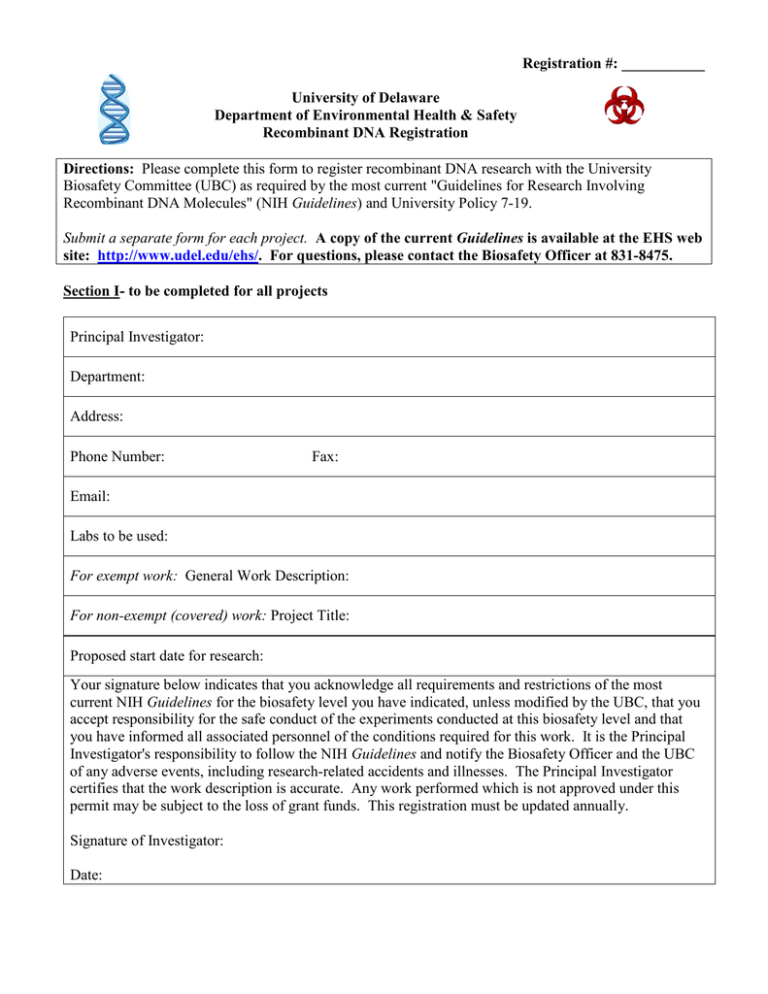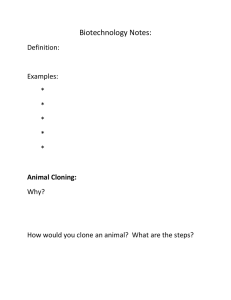Registration #: ___________ University of Delaware Department of Environmental Health & Safety
advertisement

Registration #: ___________ University of Delaware Department of Environmental Health & Safety Recombinant DNA Registration Directions: Please complete this form to register recombinant DNA research with the University Biosafety Committee (UBC) as required by the most current "Guidelines for Research Involving Recombinant DNA Molecules" (NIH Guidelines) and University Policy 7-19. Submit a separate form for each project. A copy of the current Guidelines is available at the EHS web site: http://www.udel.edu/ehs/. For questions, please contact the Biosafety Officer at 831-8475. Section I- to be completed for all projects Principal Investigator: Department: Address: Phone Number: Fax: Email: Labs to be used: For exempt work: General Work Description: For non-exempt (covered) work: Project Title: Proposed start date for research: Your signature below indicates that you acknowledge all requirements and restrictions of the most current NIH Guidelines for the biosafety level you have indicated, unless modified by the UBC, that you accept responsibility for the safe conduct of the experiments conducted at this biosafety level and that you have informed all associated personnel of the conditions required for this work. It is the Principal Investigator's responsibility to follow the NIH Guidelines and notify the Biosafety Officer and the UBC of any adverse events, including research-related accidents and illnesses. The Principal Investigator certifies that the work description is accurate. Any work performed which is not approved under this permit may be subject to the loss of grant funds. This registration must be updated annually. Signature of Investigator: Date: 2 Section II- to be completed for all projects Check the appropriate registration category for experiments covered by the NIH Guidelines: All categories are defined in the NIH Guidelines A. Experiments which are exempt and do not require registration. Examples include rDNA that is: not in organisms and viruses; entirely DNA segments from a single nonchromosomal or viral DNA source; entirely from a prokaryotic host including its indigenous plasmids or viruses when propagated only in that host or when transferred to another host by well established physiological means; entirely from a eukaryotic host when propagated only in that host or a closely related strain of the same species; entirely segments from different species that exchange DNA by known physiological processes; or not a significant risk to health or the environment. NOTE: any large scale work greater than 10 liters is NOT considered exempt. If work is exempt, attach a description of the recombinant DNA procedures to be performed. B. Experiments that Require IBC Approval, Recombinant DNA Advisory Committee Review, and NIH Director Approval Before Initiation. Deliberate transfer of a drug resistance trait to a microorganism that is not known to acquire the trait naturally, if such acquisition could compromise the use of the drug to control disease agents in humans, veterinary medicine, or agriculture C. Experiments that Require NIH/ORDA and IBC Approval Before Initiation. Cloning of toxin molecules with LD50 of less than 100 nanograms per kilogram body weight D. Experiments that Require IBC Approval, Human Subjects Approval, and NIH/ORDA Registration Before Initiation. Submit completed Appendix M, I-V from the NIH Guidelines along with this document. Deliberate transfer of recombinant DNA or DNA or RNA derived from recombinant DNA into one or more human subjects (human gene transfer) E. Experiments that Require IBC Approval Before Initiation 1. Experiments using Risk Group 2, Risk Group 3, Risk Group 4, or Restricted Agents as HostVector Systems 2. Experiments in which DNA from Risk Group 2, Risk Group 3, Risk Group 4, or Restricted Agents is cloned into nonpathogenic prokaryotic or lower eukaryotic Host-Vector Systems 3. Use of infectious DNA or RNA viruses or defective DNA or RNA viruses in the presence of helper virus in tissue culture systems 4. Experiments involving recombinant DNA in animals or transgenic whole animals 5. Experiments involving whole plants, to include exotic infectious agents that may impact ecosystems, transmissible exotic infectious agents in the presence of their specific arthropod vectors, sequences encoding vertebrate toxins introduced into plants or associated organisms, or microbial pathogens of insects/animals associated with plants if microorganism may impact ecosystem 6. Experiments involving more than 10 liters of culture F. Experiments that Require IBC Notice Simultaneous with Initiation 1. Formation of recombinant DNA molecules containing no more than two-thirds of the genome of any eukaryotic virus in tissue culture with no helper virus 2. Recombinant DNA modified plants that are noxious weeds or can interbreed with noxious weeds. Plants associated with recombinant DNA modified non-exotic microorganisms which have the potential for serious impact on ecosystems. Recombinant DNA modified arthropods or small animals associated with plants if these materials have no serious impact on ecosystems 3. Experiments involving recombinant DNA modified whole plants or organisms (if not included in Category E5 above) 4. Generation of transgenic rodents where genome is altered by stable introduction of rDNA into 3 germ line, if it requires only BSL1 containment Section III- to be completed for covered (non-exempt) projects only 1. Names of individuals participating in project, with job title: 2. Source(s) of DNA/RNA sequences (include genus, species, gene name and abbreviation): 3. Is a vector required? Yes No If yes, identify specific phage, plasmid, or virus: Virus vector: Adenovirus Defective: Yes Retrovirus Other No Replication competent: Yes No If viral vector, what percent of the viral genome remains? 4. If the recombinant contains viral DNA, does the insert represent more than 2/3 of the viral genome? Yes No 5. Is a helper virus required? Yes No If yes, specify: 6. What is the biological activity of the gene product or sequence inserted? 7. Will a deliberate attempt be made to obtain expression of the foreign gene encoded in the recombinant DNA? Yes No 8. Host strain for propagation of the recombinant (give genus, species, and parent strain): 9. Target recipient of recombinant DNA (indicate species or cell lines used): Animals: Tissue Culture: Plant cells: Plants: Gene therapy: Specify target host(s) - human, animal species: 10. Proposed biosafety level for project (check one): 1 2 3 11. Have all personnel involved in this project been trained to the appropriate biosafety level? Yes No 12. Dual Use Research- Check any categories below that apply to your project: Renders a useful vaccine ineffective Adds antibiotic resistance affecting response to a clinically useful drug Enhances pathogen virulence Increases pathogen transmissibility Widens a pathogen’s host range Enables a pathogen to evade diagnostic or detection modalities Weaponization (e.g. environmental stabilization of pathogens) None of the above 4 13. Be sure to attach a description of the recombinant DNA procedures to this form. Include the following items: nature and purpose of the project; outline the procedures and techniques; risk to personnel; practices/equipment/facilities to protect the personnel; methods to inactivate and dispose of the agents. Sufficient detail must be provided to understand the project and review the rDNA procedures. Section IV- For UBC Use Only Project/work exempt from recombinant DNA NIH Guidelines. (Make sure Work Description is attached). Project/work requires registration according to NIH Guidelines. The PI and staff can safely perform this work with the training, work practices, and lab facilities listed. The following signatures indicate provisional approval by the University Biosafety Committee for this project involving recombinant DNA technology. The work is to be performed according to NIH requirements. Final approval for projects that are NOT exempt from the NIH Guidelines will not be granted until after review by the entire UBC at the next meeting. Non-exempt work covered under this approval cannot begin until final approval is received. UBC Member Conducting Review Print Name: Signature: Date: Biosafety Officer Print Name: Signature: Date: Expiration date: Final UBC approval date: UBC Representative Signature: UBC Comments:






